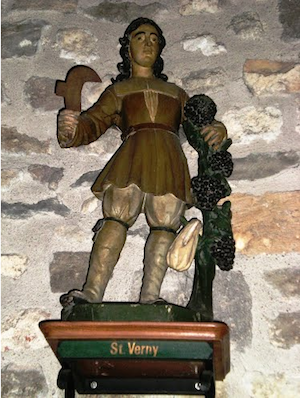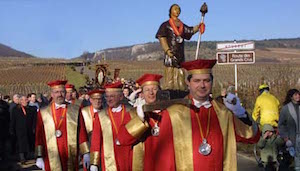
Throughout the year, different Saints are called upon and feted at critical moments in the vine's growth cycle. For example, Saint Morand de Cluny, celebrated on the 3rd June, notably in Burgundy, Champagne and Alsace, protects the vines from late frosts, and helps ensure a good flowering season. It became legend when his priory was short of wine one day for his guests, and so he made the sign of a cross on a barrel which immediately filled up with wine! The Saint Vincent marks the end of the winter rest of the vines, even if nowadays, the whims of the weather cause us to sometimes question the tradition.
The great diversity of the Patron Saints hails from the religious traditions and books that recount the life of martyrs, where wine is often used to signify spilt blood. But in the more down to earth cases, the Saints can often be traced back to the origins of winemaking in certain regions. It was Saint Martin, for example, that is said to have introduced vines in the Loire Valley in the 4th century, and that his donkey discovered the benefits of pruning. At the Marmoutier Abbey near Tours, the brave beast munched upon a few vine branches. The following harvest, the monks noted that despite being fewer, the grapes were much fatter, and of a much better quality on the vines that had nourished the donkey.

Another well known figure to winemakers is Saint Vernier, the French adaptation of the German Saint Werner. He was assassinated in 1287 and his body found on Good Friday. He was considered a martyr, and his cult appeared in the 16th century in Lorraine and the Franche-Comté regions of France as part of the German Saint Empire. In Auvergne, he is known as the Saint Verny and he was honoured until the 19th century. But he was unable to do anything to protect the vines from the phylloxera, and the angry winemakers threw statues of him in the Allier forest or in the village fountains. It's not always easy being a Saint!
In the 20th century, the Saint Vincent following has become the most widespread. Saint Vincent, the Deacon and Bishop of Saragossa, died under torture in 542. His story says that during the 542 siege of Saragossa, Childebert, the King of France, and Clotaire, the King of Soissons, were touched with pity towards the inhabitants who had formed a procession behind the relics of Saint Vincent. They exchanged the relics for a lifting of the siege. The relics were moved to Paris and laid in the Sainte-Croix-Saint-Vincent Abbey, which has now become Saint-Germain-des-Prés, where the monks cultivated vines. And a patron Saint is born! Since 1938, he is honoured once a year by the knights of the Tastevin in Burgundy.

Many other traditions remain to this day. For example on the 15th August, Assumption Day, the first fruit from the vines are offered to the Virgin Mary. Vine, wine and the Saints are intimately linked, but is not the only example of gastronomic patronage. To name but a few, Saint André the Patron Saint of fishermen and fish, Saint Antoine du Désert, the Patron of charcuterie and pig farmers, and Saint Honoré, the Patron of bakers, pastry cooks and confectioners.
Comments
No comments.




